



The 2016 FIDE World Chess Candidates Tournament is a 14-round event, which determines the next Challenger to Magnus Carlsen's title, is taking place in Moscow from March 10–30. Eight players, including six of the World’s top-ten rated grandmasters. The time control is 100 minutes for the first 40 moves, 50 minutes for the next 20 moves and then 15 minutes for the rest of the game, plus an additional 30 seconds per move starting from move one. The guaranteed prize fund is US $420,000.
| Round 2, Saturday 12 March 2016 | ||
| Svidler Peter | ½-½ |
Topalov Veselin |
| Aronian Levon | ½-½ |
Anand Viswanathan |
| Caruana Fabiano | ½-½ |
Giri Anish |
| Karjakin Sergey | 1-0 |
Nakamura Hikaru |
It was the last day of the Aeroflot Open 2016. After seven hours of intense chess Boris Gelfand won his game against Rinat Jumabayev and finished joint first at the event along with Evgeniy Najer. At the closing ceremony I approached Gelfand with a request. “Boris, I would like to do an interview with you for the ChessBase newspage. Will you have some time tomorrow?” Boris thought for a few seconds, “Tomorrow is the blitz event and I have to leave immediately after it ends. How about we find some time during the Candidates? I will be commentating on the first two days at least, and we can work something out.” I agreed, fully aware that at the Candidates it might be very difficult to get hold of him. After all there are always dignitaries coming to the tournament hall and a player like Boris is always in great demand. Yet, I hoped that this interview would take place, as Gelfand’s knowledge, skills and honest opinions about chess could help every aspiring player.
Come 12th of March and the second round of the Candidates just got underway. I went to the press room to set up my laptop and other stuff. We were 15 minutes into the game and the Israeli number one barged into the press room. “Let’s do the interview”, he said. It was overwhelming in a way! Here was a guy who was not only was a strong chess player but had great human qualities like keeping his word.

The interview consists of 58 minutes of chess
discussions with Boris on varied topics that
will benefit many chess players. The interview will be published on the
website soon.
The reason for writing such an elaborate introduction about the interview was the sheer co-incidence of two of the games having quite a substantial connection with Gelfand’s games of the Aeroflot Open – the biggest one being Levon Aronian versus Vishy Anand, where the Armenian number one played the same novelty that Gelfand had essayed on 6th of March 2016 in his game against Boris Grachev.
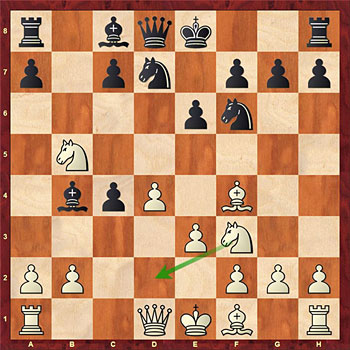
Five games had reached this position before
and everyone had played 8.Nc3. Boris Gelfand played
8.Nd2!? in his game against Grachev, and the same idea was picked up by
Levon Aronian.

This position between Sergey Karjakin and Hikaru
Nakamura is the same that was
reached between Gelfand and Martirosyan from the second round of the Aeroflot
Open.
Moral of the story: Top players follow the games of other top players and grab onto any new idea or improvements they can learn from them.

Aronian faced grave pressure in the first round against Anish Giri when the latter employed the 5.Bf4 variation in the Queen’s Gambit Declined. The Armenian thought that it was a good idea to try this same line with the white pieces. However, Anand was quite clever in the opening and instead of committing his dark-squared bishop, he started with 4…Nbd7. Both the players were armed to the teeth with home preparation. Also they were very well aware of the recent game between Boris Gelfand and Boris Grachev from the Aeroflot Open 2016. Anand found the important manoeuvre Ba6-b5-a4 at the key moment and Aronian couldn’t really press with the white pieces. In the final position Vishy was a pawn up, but thanks to the opposite coloured bishop endgame there was nothing much to play for.

It is always nice to know what is the difference between playing 4…Nbd7 and 4…Be7? Apart from reserving the option of developing the bishop to any other square apart from e7, this move also leads to the concrete line starting with 5…dxc4 and 6…b5 that was played by Vishy Anand in this game.

[Event "FIDE Candidates 2016"] [Site "Moscow RUS"] [Date "2016.03.12"] [Round "2"] [White "Aronian, Levon"] [Black "Anand, Viswanathan"] [Result "1/2-1/2"] [WhiteElo "2786"] [BlackElo "2762"] [Annotator "Sagar Shah"] [PlyCount "61"] [EventDate "2016.03.10"] {Levon Aronian has always been a tough opponent for Vishy Anand. The Armenian has had a good score against the Indian, but quite often Anand has been able to create certain brilliancies against Levon, for instanc their game at the Wijk Aan Zee 2013.} 1. d4 Nf6 2. c4 e6 {Anand starts off with the flexible moves Nf6 and e6. This gives him a lot of options – to play the Nimzo, QGD, Ragozin and also the Benoni if the need arises.} 3. Nf3 d5 4. Nc3 Nbd7 $5 { This idea of developing the knight on d7 before the bishop on f8 is interesting. The point of this move is that the bishop can develop on e7 or b4. This keeps all options open. And as Vishy mentioned after the game: Nbd7 is transpositional in nature and gives Black many more opportunities.} 5. Bf4 { After suffering for the entire game yesterday from the black side of the QGD 5. Bf4, Aronian thinks that this is a good idea to try it as White!} dxc4 $5 (5... Be7 6. e3 O-O $1 {takes us to the main line of the 5.Bf4 QGD.}) 6. e3 {This is quite an important position and the main moves here have been ...Nb6 and ... Nd5. Even a6 has been popular. But Anand opts for the move 6... b5!? which has only been played 19 times before.} b5 {So what is the idea of this move, you may ask. Well first of all you are simply saving the pawn on c4. Hence, the logical move is to take on b5. But after} 7. Nxb5 {Black gets to develop with a tempo with the move:} Bb4+ 8. Nd2 $5 {This move has only been played once before in this particular position and only a week ago by Boris Gelfand in his game against Boris Grachev from the Aeroflot Open 2016. The height of coincidence is that when this move was made, Gelfand was sitting right besides me. He told me that this was played by him against Grachev in the Aeroflot Open 2016. I asked him whether he thinks Aronian knew the game and followed his idea. Gelfand said: "Aeroflot is a great tournament, and I am one of the top players. So it wouldn't come as a surprise if Aronian had not missed this game!"} (8. Nc3 {is the only move that has been played before by top players like Wojtaszek, Karjakin, Roiz, Gustaffson and Bu. Play might continue something like this:} Nd5 9. Rc1 N7b6 {with a complex position.}) 8... Nd5 { Vishy Anand paused for a while before making this move. Most probably recalling his analysis.} 9. Bg3 N7b6 10. Qc2 O-O 11. Be2 (11. Bxc4 Nxc4 12. Qxc4 Ba6 $19 {wouldn't be very good for White.}) 11... Ba6 12. Nc3 c5 $1 { Black is ahead in development and hence makes the right decision to open up the position.} 13. dxc5 {Until now we have been following the game between Gelfand-Grachev and through transposition we also have the game of Lenic vs Stern. At this point, however, Anand deviates and instead of directly taking on c5, he first takes on c3 and then picks up the c5 pawn.} Nxc3 14. bxc3 Bxc5 15. O-O {Both sides have castled and the opening phase is now over. Let us try to understand what's going on. The pawn on c4 gives Black space but it also limits Black's possibilities, as two of his pieces are tied down. It may look like White is slightly better, but Black is holding the balance.} Rc8 16. Rfd1 Qg5 (16... Qf6 {is also possible as} 17. Ne4 {is met with} Qf5 18. Rac1 Be7 { with an interesting position.}) 17. Nf3 Qg6 18. Qd2 Bb5 $1 {This is the key move of the entire game. It is a common idea in this structure: Black reroutes his bishop to a4 where it will be much more useful than on a6.} 19. Qe1 { Aronian made this move quite quickly, which felt as thought he was still in his home-preparation. But as he mentioned after the game, he seemed to have a deja vu feeling that he had seen this before at home, when actually it was quite possible that he hadn't. In any case this is pretty good move with the idea of meeting Ba4 with Rd2.} Ba4 20. Ne5 (20. Rd2 $6 f6 $1 {Was the important point. Hence it is neccessary to insert Ne5 before playing Rd2.}) 20... Qg5 21. Rd2 (21. Nf3 {trying to repeat the position would be incorrect as after} Qe7 22. Rd2 f6 {with the idea of e5, Black is clearly better.}) 21... Rfd8 22. Rxd8+ Qxd8 (22... Rxd8 {was also possible.} 23. Nxc4 Nxc4 24. Bxc4 $14 {Black has compensation but he will not be regaining his pawn any time soon.}) 23. Nxc4 Nxc4 24. Bxc4 Bxe3 $1 {The most clear cut way to equalize.} (24... Ba3 {is also possible but after} 25. Bb3 Bxb3 26. axb3 Bb2 27. Rxa7 $14 {White has a small edge.}) 25. Qxe3 (25. Ba6 Bd2 26. Qe4 Bc6 $1 {An important move to foresee.} 27. Qe5 Ra8 28. Rd1 Qb6 $11) 25... Rxc4 26. Rb1 Rc8 27. h3 (27. Qxa7 Bc2 28. Rc1 Rxc3 $11) 27... a6 28. c4 Rxc4 29. Rb8 Rc8 30. Qb6 Rxb8 31. Qxb8 { And rather than trying to play this pawn up endgame which would anyway end in a draw after 30 odd more moves, due to the opposite coloured bishops, Anand agreed to a draw. A wise decision considering that there is such a long event left ahead.} 1/2-1/2

You can always bank on Vishy Anand to be well prepared in the lines that he plays

“19.Qe1 may not be a move that I had prepared, but I always have a feeling of déjà vu when I see a position and think that this is something that I have worked on at home!” (Levon Aronian after the second round).

Two of the youngest participants of the Candidates locked horns against each other in the fashionable line of the Anti-Berlin Defence. Fashionable, because Vishy Anand had played the same line against Veselin Topalov in the first round and had emerged victorious. Both the players had at least some experience in this opening. Fabiano had played a game against Topalov at the Sinquefield Cup 2015 with the black pieces, while Anish’s good friend Dutch GM Benjamin Bok already had three games in that line. Caruana’s direct Qd1 without inserting a4 move was a novelty. Anish’s reaction was quite provocative. He allowed the white pawn to come to e6. It seemed as if Caruana had some pressure on the position, but his time was just too low for him to take any sort of calculated risks. In the end he settled for the most natural moves and the game ended in a draw.

[Event "FIDE Candidates 2016"] [Site "Moscow RUS"] [Date "2016.03.12"] [Round "2"] [White "Caruana, Fabiano"] [Black "Giri, Anish"] [Result "1/2-1/2"] [ECO "C65"] [WhiteElo "2794"] [BlackElo "2793"] [Annotator "Amruta Mokal/ Sagar Shah"] [PlyCount "83"] [EventDate "2016.03.10"] 1. e4 e5 2. Nf3 Nc6 3. Bb5 Nf6 4. d3 Bc5 5. c3 O-O ({Anish opted for} 5... d5 { against MVL in Tashkent 2014. The game ended in a comfortable draw. 1/2 (32)-1/ 2 (32) Vachier Lagrave,M (2757)-Giri,A (2768) Tashkent 2014}) 6. O-O d6 7. Nbd2 {Caruana had earlier gone for 7.h3 in Malmo 2012 against Giri! Four years later, both are players have become super strong and we are sure to see many more battles in the years to come.} (7. h3 Ne7 8. d4 Bb6 9. Re1 c6 10. Bd3 Ng6 11. Be3 Re8 12. Nbd2 {1-0 (41) Caruana,F (2770)-Giri,A (2693) Malmo 2012}) 7... Ne7 8. d4 exd4 9. cxd4 Bb6 10. Re1 Bg4 11. h3 Bh5 {All this was seen in the game Anand-Topalov from the first round of the Candidates 2016. Anand went 12. a4 in this position. Caruana prefers to break the pin immediately and plays Qb3.} 12. Qb3 d5 {Recently Caruana himself played this with Topalov in Sinquefeld Cup 2015 and won a nice game. Its important to note though he won with black he still chose to play this line from white. This shows that the top players analyze their games objectively and make use of any new ideas that they come across, especially in their own games.} 13. e5 Nd7 14. Qd1 {[%cal Gd1b3,Gb3d1] What's going on?!! Qd1-b3-d1? Is Caruana our of his mind? Not really! Things in the centre are settled now and the queen doesn't mind this backward move, mainly vacating the b3 square for the knight.} f6 $5 { Immediately challenging the center. As Giri said during the press conference, he thought that this line was fine for Black, but after the game he thinks that his seconds somehow had underestimated the dangers in the position.} 15. e6 Nb8 {Undeveloping moves seem to be the order of the day. However, to be fair, the knight simply didn't have a good square to go to.} 16. Nb3 {Eyeing for the c5 outpost which would force Black to part with his dark squared bishop. At the same time the route for the bishop to develop on d6 has been opened.} Qd6 (16... Nbc6 {was possible but it seems as if Anish wanted to prevent his opponent from going Bf4.}) 17. g4 Bg6 18. Nh4 Nbc6 19. Bxc6 (19. Nxg6 Nxg6 {looks fine for Black.}) (19. Ng2 {preparing Bf4 can be an option, but Black has a strong move in the form of} f5 $1 20. Bf4 Qb4 21. Bxc6 Nxc6 $11 ) 19... Qxc6 (19... bxc6 20. Ng2 {is now a clearly better position for White as Bf4 is threatened and there is no bishop to attack on b5 with Qb4.} f5 21. Bf4 Qb4 22. a3 Qa4 23. g5 $16 {Black is left without any countrplay.}) 20. Bd2 {White is ready to give up the d4 pawn in order to get good amount of piece activity.} (20. Bf4 {is natural but it always seems dangerous to put a piece where a pawn fork can happen. In this case the move g7-g5.} Bc2 21. Qd2 Bxb3 22. axb3 g5 23. Bxg5 fxg5 24. Qxg5+ Kh8 {Giri showed some blistering analysis in this position. One of the lines that was very entertaining was the following.} 25. Qe5+ Kg8 26. Nf5 Nxf5 27. gxf5 Qd6 28. f6 Qxe5 29. dxe5 $16 { [%csl Ge5,Ge6,Gf6] Anish gave us an example of four rows of pawns (32 pawns!) vs all the other pieces. Truly wonderful the kind of thing these top players like to indulge in!}) 20... Bc2 21. Qe2 Bxb3 22. axb3 Bxd4 {Although Black has won a pawn, it doesn't really matter. The pawn on e6 is a monster and the rook on a1 is also activated without any efforts. Giri has to play carefully here.} 23. Bb4 Bc5 (23... Rfe8 $2 24. Bxe7 Rxe7 25. Nf5 $18) 24. Rec1 b6 25. Bxc5 bxc5 26. Ra6 (26. Ra5 {winning the c5 pawn could have been even stronger.}) 26... Qb7 27. Rxc5 Rfe8 28. Qb5 {It was possible to play more aggressively, but Caruana had already spent a lot of his thinking time and hence decided it was safer to simplify the game.} (28. Nf5 $142 $1 Qxb3 29. Ra3 $1 (29. Rxc7 $2 Nxf5 30. gxf5 Qxh3 $11) 29... Qb4 30. Rxc7 $16) 28... Qxb5 29. Rxb5 d4 $1 {This pawn is the soul of Black's position. It will create threats and give him the necessary counterplay.} 30. Nf5 (30. f4 {looks natural.} Rad8 31. Nf3 d3 32. Nd2 {This was Vladimir Kramnik's suggestion. White threatens f5 now, so Black must do something about it.} f5 $1 33. gxf5 (33. Kf2 {looks stronger but after} Rd5 {it should nevertheless be around equal.}) 33... Rd5 34. Rxd5 Nxd5 35. Rxa7 Rf8 $11) 30... Rad8 31. Rxa7 (31. Nxe7+ Rxe7 32. Kf1 d3 33. Ke1 Rde8 34. Kd2 Rxe6 35. Rxe6 Rxe6 36. Kxd3 Rd6+ $11) 31... Nxf5 32. gxf5 d3 {Now it is just a draw.} 33. Ra1 g6 34. Rc5 Re7 35. Rd1 gxf5 36. Rc6 Rd4 37. Kg2 Kg7 38. Kf3 Kg6 39. Rc4 Rd5 40. Rc3 d2 41. Re3 Rd6 42. Re2 {An exciting game where we could have seen even more fireworks had Caruana not been under time pressure.} 1/2-1/2

If Caruana would have managed his time better might well have seen another decisive result today
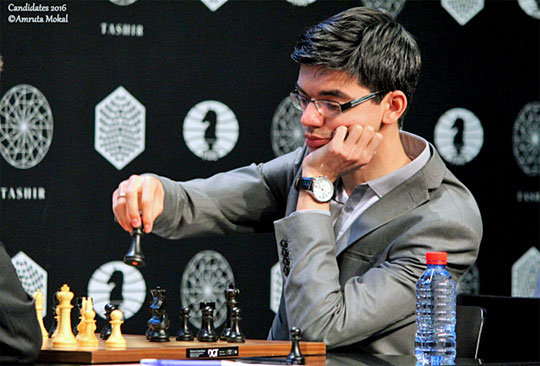
Anish Giri definitely seems to have come to Moscow in a fighting mood

The analysis session was highly entertaining.
Fabiano: “This was too deep for me.”
Anish: “A few more press conferences with me and you will start considering
such moves!”
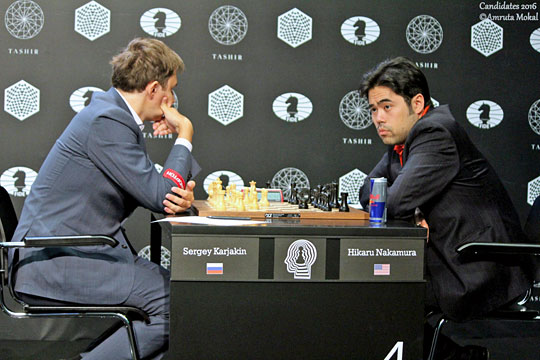
It would not be inappropriate to say that Sergey Karjakin simply outplayed Hikaru Nakamura today. The Russian, who had the white pieces, slowly increased his pressure. As Vladimir Kramnik, who was in the commentary box during round two, rightly pointed out: “Black must do something pretty soon or else he would simply have to suffer for the rest of the game.” And Nakamura is definitely not a player who likes to suffer. He sacrificed his knight on g3 and calculated that he would win back the piece along with interest. Turns out that Karjakin had seen one move further and Nakamura ended up with a knight less! In the end there was nothing to be done. With a complete piece down, Hikaru had to resign.

In this position Nakamura took on g3. What
exactly was his idea and
how is it refuted. Try to see if you can play like Karjakin to win the game!

[Event "FIDE Candidates 2016"] [Site "Moscow RUS"] [Date "2016.03.12"] [Round "2"] [White "Karjakin, Sergey"] [Black "Nakamura, Hikaru"] [Result "1-0"] [ECO "E15"] [WhiteElo "2760"] [BlackElo "2790"] [Annotator "Sagar Shah"] [PlyCount "75"] [EventDate "2016.03.10"] 1. d4 Nf6 2. c4 e6 3. Nf3 b6 4. g3 Ba6 5. b3 Bb4+ 6. Bd2 Be7 7. Bg2 d5 ({ Of course} 7... c6 {is the main line, but 7...d5 is also becoming quite popular these days.}) 8. cxd5 exd5 9. O-O O-O 10. Nc3 Nbd7 11. Qc2 {Sergey makes the normal developing moves and looks forward to a complex middlegame.} Re8 12. Rfd1 Nf8 (12... Rc8 {with the idea of directly going c5 would be more appropriate.}) 13. Ne5 Bb7 14. Bc1 $5 {The bishop would be much better placed on b2.} Ne6 15. Bb2 Bd6 {The threat is Nxd4.} 16. e3 (16. Nb5 $5 Nxd4 17. Bxd4 Bxe5 18. Bxe5 Rxe5 19. Qxc7 $14) 16... a6 17. Ne2 c5 $6 {Black is absolutely not ready for this opening of the center. Firstly have a look at the white pieces. They are just perfectly situated: the bishops on long diagonals, one knight in the center, the other ready to jump to f4 to put further pressure.} ( 17... c6 {Trying to hold was the right way to proceed.}) 18. dxc5 Nxc5 (18... bxc5 19. Nc4 $1 Bc7 20. Nf4 $16) 19. Nd3 Nce4 20. Rac1 {Kramnik, who is so good at such technical positions, felt that Black must do something quickly or else he would just have to suffer with a passive and inferior position.} Rc8 21. Qb1 Qe7 22. Bd4 Rxc1 23. Rxc1 b5 24. b4 {The sad face of the bishop on b7 determines White's advantage} Nd7 25. a3 Nf8 26. Ba1 Ne6 27. Qa2 Bc7 28. Nd4 Bb6 29. h4 $5 {[#] Karjakin has things under control and he tries to gain some space on the kingside. It is true that this weakens the g3 square, but is it concretely dangerous? Nakamura thinks so and that explains his next move.} Nxg3 $4 {A huge blunder at this level. But as it is rightly said, such blunders do not happen in vaccuum. It was the sustained pressure of Karjakin that prompted Hikaru to make the mistake.} (29... Nxd4 30. Bxd4 Bxd4 31. exd4 Qf6 $14 { is slightly worse but nonetheless playable.}) 30. fxg3 Nxd4 31. Bxd4 Bxd4 32. exd4 Qe3+ {Hikaru must have ended his calculations at this point. The knight on d3 is hanging and if Nf2 then the c1-rook hangs. So White has to give back the piece. But Sergey has seen a move further.} 33. Qf2 $1 Qxd3 34. Rc7 $1 { [%cal Gc7f7,Gc7b7] A strong double attack and just like that Black loses a piece.} f5 35. Rxb7 h6 36. Bxd5+ Kh7 37. Bg2 Re2 38. Bf1 {A painful defeat for Hikaru, but still a long way to go.} 1-0

Things didn’t work out so well for Hikaru
today. But it is a long event.
With twelve rounds to go he can surely make a comeback.
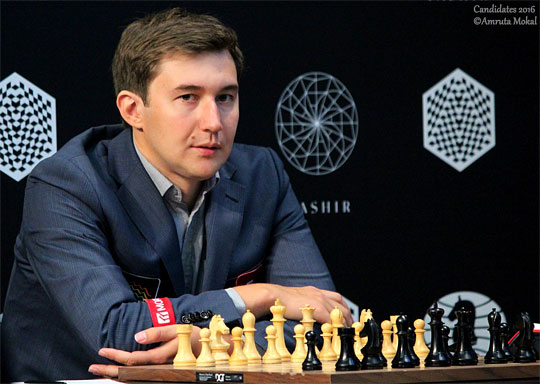
Seeing one move further – Sergey Karjakin joins the leader with a round two win
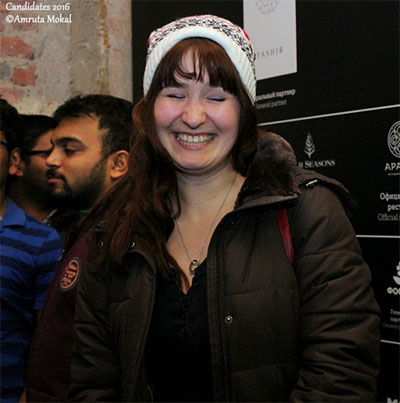
A huge smile is natural, when your husband
wins! Galiya Kamalova,
wife of Sergey, came to the tournament hall at the end of the game

What is more boring than the Berlin endgame? The Nxe5 symmetrical pawn structure line in the Berlin! Svidler tried a line in which Alexander Areshchenko had beaten Etienne Bacrot from the white side. But Topalov was pretty well prepared and after a few accurate moves, the players shook hands and a draw was agreed. After Topalov’s loss yesterday it is surprising that Peter didn’t press harder with the white pieces. But it is a long tournament and one can understand that the players are just getting into the groove.

[Event "FIDE Candidates 2016"] [Site "Moscow RUS"] [Date "2016.03.12"] [Round "2"] [White "Svidler, Peter"] [Black "Topalov, Veselin"] [Result "1/2-1/2"] [WhiteElo "2757"] [BlackElo "2780"] [Annotator "Sagar Shah"] [PlyCount "60"] [EventDate "2016.03.10"] 1. e4 e5 2. Nf3 Nc6 3. Bb5 Nf6 4. O-O Nxe4 5. Re1 Nd6 6. Nxe5 {nine times out of ten when this line is played we can expect a draw.} Be7 7. Bf1 Nxe5 8. Rxe5 O-O 9. Nc3 Ne8 10. Nd5 Bd6 11. Re1 c6 12. Ne3 Be7 13. c4 Nc7 14. d4 d5 15. cxd5 {All this has been seen in the game Areshchenko-Bacrot. Bacrot took on d5 with his knight, but Topalov improves with Bb4.} Bb4 16. Bd2 Bxd2 17. Qxd2 Nxd5 18. Nxd5 Qxd5 19. Re5 Qd6 20. Bc4 Bd7 {An accurate move connecting the rooks.} 21. Rae1 b5 22. Bb3 a5 23. a4 bxa4 24. Bxa4 Be6 25. Rxa5 Rxa5 26. Qxa5 Qxd4 27. Bxc6 Qxb2 28. Bd5 Bxd5 29. Qxd5 Qf6 30. g3 g6 {As you can see nothing really substantial happened and a draw was agreed.} 1/2-1/2

What do you do when your games ends in an hour from the start? Pose for pictures…

….or kibitz live games with friends.
Here you see Ilya Merenzon, CEO of Agon, Arkady Dvorkovich,
an economist who was a Deputy Prime Minister in Dmitry Medvedev's Cabinet,
Peter Svidler and Mark Glukhovsky, Chairman of the RCF Management board.
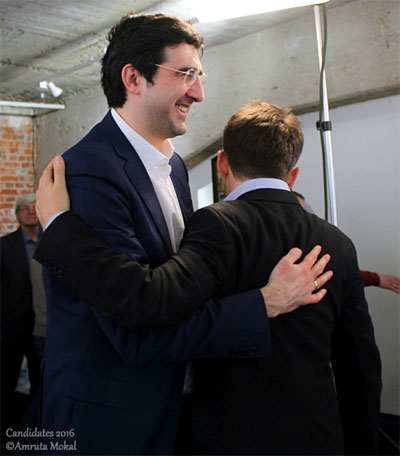
It was a pleasure to see Vladimir Kramnik in
the commentary room and the players
too were happy to see their friend and rival! Here Levon Aronian greets
the big Vlad

Indian chess supporters follow Vishy wherever he goes!

Bird’s eye view of the press center and the live games big screen
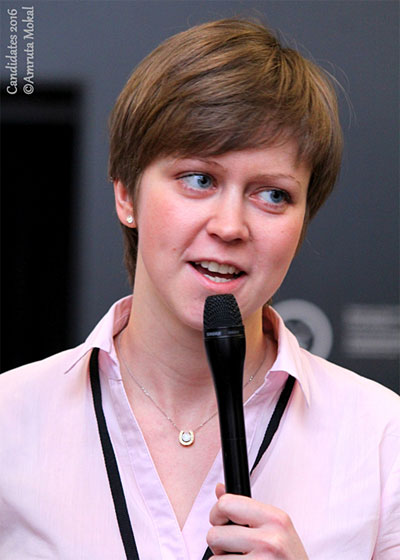
Anna Burtasova, who conducts interviews with
top grandmasters and dignitaries
at the venue, is a WGM, chess journalist and the producer of Chesscast broadcasts
Pictures by Amruta Mokal of ChessBase India,

|
|
|||||||||||||||||||||||||||||||||||||||||||||||||||||||||||||||||||||||||||||||||||||||||||||||||||||||||||||||||||||||||||||||||||||||||||||||||||||||||||||||||||||||||||||||||||||||||||||||||||||||||||||||||||||||||||||||